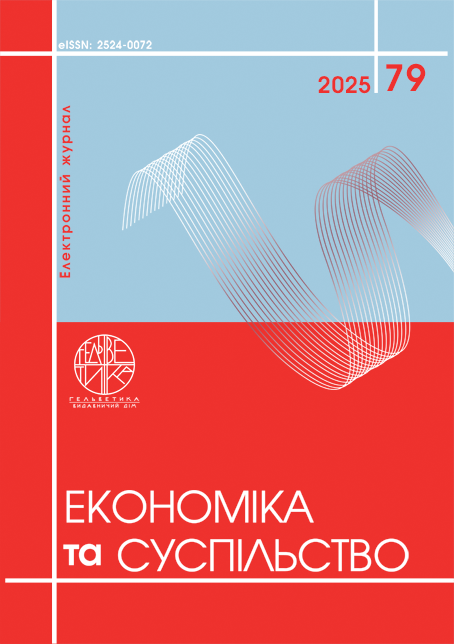THE IMAGE-BUILDING AND STRATEGIC ROLE OF A TRADEMARK IN ENSURING COMPETITIVENESS
Abstract
For companies to remain competitive amidst digital transformation and intensified market rivalry, the focus is shifting from the product's quality alone to its personalized image. This image, crafted and sustained by a successful trademark, becomes a key tool for differentiation in the consumer's mind. Thus, a trademark evolves from a simple marketing element into a company's strategic asset. This necessitates a deeper analysis of its place and role within the overall system of enterprise competitiveness management. The effective use of a trademark not only helps secure market position but also creates long-term competitive advantages. The main goal of this research is to conceptualize and systematize the place and role of a trademark as a key element in a company's competitiveness management system. The study employed the following scientific methods: theoretical generalization, analysis, synthesis, and a systemic approach. The theoretical foundation is based on academic works dedicated to the formation of trademark competitiveness and its role in a company's competitiveness management system. The publication systematizes the features of forming a trademark's competitiveness as a determinant of a company's success in a dynamic business environment. It formulates an original perspective that positions the trademark within the competitiveness management system based on three levels: competitive potential (the resource base and capabilities that form the brand's foundation), competitive position (the brand's perception and differentiation in target markets), trademark value, or brand equity (a financial reflection of its strength and prospects). The proposed model allows for the effective integration of intangible assets into a company's management framework, which is crucial for ensuring strategic development and achieving sustained competitive advantages. The methodology presented allows a trademark to be viewed as a key strategic asset in the company's competitiveness management system. This ensures the potential for creating long-term competitive advantages. Prospects for future research include developing tools for assessing trademark competitiveness and studying its impact on a company's overall stability in an unstable market environment.
References
Вербівська Л. В. Теоретичні засади управління конкурентоспроможністю підприємства в контексті системного підходу. Економічний простір. 2023. № 187. С. 78–83. DOI: https://doi.org/10.32782/2224-6282/187-13
Григор’єва О. А., Григорчук С. Л. Формування бренду як складова конкурентоспроможності підприємства. Маркетинг і менеджмент інновацій. 2024. № 4. С. 234–243.
Завгородня О. В. Системні характеристики управління конкурентоспроможністю підприємства. Економіка та держава. 2022. № 2. С. 45–48.
Корж В. В., Мельниченко О. А., Бабій С. Ю. Управління конкурентоспроможністю: елементи, взаємозв'язки та функції. Економічний вісник. 2023. № 3. С. 112–118.
Мішустіна Т. С. Тороговельна марка як фінансовий актив українських підприємств. Бюлетень Міжнародного Нобелівського економічного форуму. 2012. Т. 2, № 1 (5). С. 243–252. URL: https://econforum.duan.edu.ua/images/PDF/2012/2/35.pdf (дата звернення: 15.08.2025).
Приставська Н. В. Системний підхід до управління конкурентоспроможністю підприємства. Економічний простір. 2024. № 109. С. 97–105.
Плугіна І. В., Тверденок Л. О. Внесок торговельної марки у формування конкурентної переваги компанії. Економічний форум. 2025. № 2. С. 58–64.
Середа О. Визнання торговельної марки добре відомою // *Армада*. – 24.01.2025. URL: https://armada.law/blog/vyznannya-torgovelnoyi-marky-dobre-vidomoyu/) (дата звернення: 01.08.2025).
Aaker D. Measuring brand equity across products and markets. California Management. 1996. № 38(2). P. 102–120. URL: https://www.academia.edu/7284936/Aaker_1996_Measuring_Brand_Equity_Across_Products_and_Markets (дата звернення: 22.07.2025).
Barwise P. Brand equity: Snark or Boojum? International Journal of Marketing Research. 1993. № 10 (March). P. 93–104.
Feldwick P. What is brand equity anyway, and how do you measure it? Journal of the Market Research Society. 1996. № 38(2). P. 85–104.
Gupta S., Gallear D., Rudd J., Foroudi P. The Impact of Brand Value on Brand Competitiveness. Journal of Business Research. 2020. № 112(5). P. 210–222. DOI: https://doi.org/10.1016/j.jbusres.2020.02.033
Kapferer J.-N. Strategic brand management. Free Press. 1994. 358 p.
Verbivs'ka, L.V. (2023). Teoretychni zasady upravlinnia konkurentospromozhnistiu pidpryiemstva v konteksti systemnoho pidkhodu [Theoretical principles of enterprise competitiveness management in the context of a systems approach]. Ekonomichnyj prostir. № 187. Pp. 78-83. https://doi.org/10.32782/2224-6282/187-13 [in Ukrainian].
Hryhorieva O. A., Hryhorchuk S. L. (2024). Brand formation as a component of enterprise competitiveness. Marketing and Innovation Management. No. 4. P. 234–243. [in Ukrainian].
Zavhorodnia O. V. (2022). Systemic characteristics of enterprise competitiveness management. Economy and State. No. 2. P. 45–48. [in Ukrainian].
Korzh V. V., Melnychenko O. A., Babii S. Yu. (2023). Competitiveness management: elements, interrelations and functions. Economic Bulletin. No. 3. P. 112–118. [in Ukrainian].
Mishustina, T.S. (2012). Torohovel'na marka iak finansovyj aktyv ukrains'kykh pidpryiemstv [Trademark as a financial asset of Ukrainian enterprises]. Biuleten' Mizhnarodnoho Nobelivs'koho ekonomichnoho forumu. Т. 2, № 1 (5). S. 243-252. URL: https://econforum.duan.edu.ua/images/PDF/2012/2/35.pdf [in Ukrainian].
Prystavska N. V. (2024). A systemic approach to enterprise competitiveness management. Economic Space. No. 109. P. 97–105. [in Ukrainian].
Pluhina I. V., Tverdenok L. O. (2025). The contribution of a trademark to the formation of a company’s competitive advantage. Economic Forum. No. 2. P. 58–64. [in Ukrainian].
Sereda, O. (2025). Vyznannia torhovel'noi marky dobre vidomoiu [Recognition of a trademark as well-known]. Armada. URL: https://armada.law/blog/vyznannya-torgovelnoyi-marky-dobre-vidomoyu/ [in Ukrainian].
Aaker, D. (1996). Measuring brand equity across products and markets. California Management. 38(2). Pp. 102-120. URL: https://www.academia.edu/7284936/Aaker_1996_Measuring_Brand_Equity_Ac ross_Products_and_Markets.
Barwise P. (1993). Brand equity: Snark or Boojum? International Journal of Marketing Research. No. 10 (March). P. 93–104.
Feldwick P. (1996). What is brand equity anyway, and how do you measure it? Journal of the Market Research Society. № 38(2). P. 85–104.
Gupta S., Gallear D., Rudd J., Foroudi P. (2020). The Impact of Brand Value on Brand Competitiveness. Journal of Business Research. № 112(5). P. 210–222. DOI: https://doi.org/10.1016/j.jbusres.2020.02.033.
Kapferer J.-N. (1994). Strategic brand management. Free Press. 358 p.

This work is licensed under a Creative Commons Attribution 4.0 International License.


